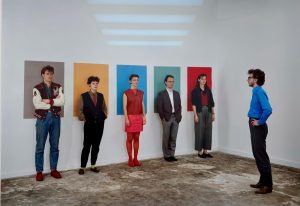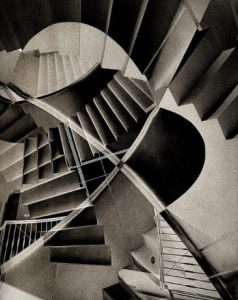For English please click here
הביאנלה ה 13 בברלין מאכזבת. כמו בכל תערוכה מרובת משתתפים, גם כאן יש גם עבודות טובות אך לאחר ביקור בשלושה מתוך ארבעת אתרי הביאנלה דומה שהתערוכה נאצרה על פי נוסחה להנפקת עכשוויות: הגירה, עוולות כלפי נשים ולהטב”קים, פוסט קולוניאליזם וכמובן “התנגדות” – מילה שהתרוקנה מתוכנה והפכה למונח – אין צורך לציין התנגדות למה ולמי.
כל אלו מצטופפים תחת הכותרת passing the fugitive on (להעביר את הנמלט). לרגעים נדמה שזהו ביקור בתערוכה שכבר היינו בה – הדוקומנטה ה 15 בקאסל והביאנלה 2024 בוונציה הן רק שתיים מהדוגמאות שעולות מיד על הדעת. ההרגשה של אירוע מאובק וממוחזר בולטת משום שעם כל האוריינטציה הפוליטית, נעדרת לחלוטין התייחסות לנושאים הבוערים ביותר בתקשורת העולמית – אין ולו אזכור , לטוב או לרע למלחמה המתמשכת בעזה (וכמובן לא לזוועת טבח אוקטובר והחטופים) אך אם ניתן ליחס זאת למדיניות הממשלה הגרמנית המשתדלת שלא לבקר את ישראל, הרי מתמיה העדר התייחסות למלחמת אוקראינה-רוסיה שממשיכה לגבות קורבנות לא רחוק מברלין, המלחמה בסודן שלא לדבר על העדר התייחסות לעליית הפשיזם בגרמניה ואירופה.

האוצרת Zasha Colah (ילידת הודו 1982) בחרה להציג אמנים בעיקר מדרום ודרום מזרח אסיה. בפגישה וסיור איתה במוזיאון לאמנות עכשווית המבורגר באנהוף Hamburger Bahnhof שבאחד מאגפיו מציגים חמישה אמנים במסגרת הביאנלה, היא הגדירה את ה”שועליות” FOXING כנושא מרכזי בבינאלה. מעבר לכך שבברלין אכן חיים שועלים הנמלטים מהאדם אפשר לראות בנושא אמירה על האופן בו אמנות יכולה להתייחס לנושאים שונים ב”ערמומיות” כלומר לבקר אך באופן עקיף . בהמבורגר באנהוף מציגה Larissa Araz (ילידת איסטנבול 1990 ) ציורי קיר ארוך בגיר ובו ציור נוף של אנטוליה וחלקים מעירק שם חי מין שועלים שב 2005 שונה משועל כורדיסטאני לשם ללא התייחסות לכרודיסטאן משום שהשלטון הטורקי ההולך ונעשה לאומני ביקש למחוק אזכורים לאומיים זרים בשמות חיות בר. Araz מציירת את השועלים הנמלטים מכל מגע עם האנושי לצד שיירות פליטים שגם הן חומקות מרודפים.


עבודה נוספת היא סרט המתעד פעולות רחוב של קבוצה פולנית Akademia Ruchu, שיצרה ב 1977 הפנינג אבסורד. חבריה הקבוצה מועדים בכוונה שוב ושוב לפני בניין המפלגה הקומוניסטית בוורשה וכך ממחישים חוסר יציבות תוך רמיזה לאדמה שהחלה לרעוד תחת רגלי השלטון. לצד הסרט עבודות טקסטיל מהודו שמוצפנים בהם מסרים נגד אלימות נגד נשים . היחס בין העבודות, האמירה הכוללת של ההצבה – נותרות פרומות .

הצרוף של מידה של חוסר קוהרנטיות ודידקטיות שמאפיים את התערוכה בהמבורגר באנהוף ממשיכ גם ב KW Institute for Contemporary Art. קומה של עבודות שנוצרו כאמנות רחוב לאחר ההפיכה הצבאית במיאנמר ב 2021 מציגה פיסול רך וצבעוני שמגחך דמויות פוליטיות ופרקטיות שליטה אלימות. הטון המשחקי – אירוני לא מצליח ליצור אמירה נדמה כמתאמץ לשעשע והריבוי מחליש במקום לחזק. המיצב Joker’s Headquarters Gesamtkunstwerk as a Practical Joke המוצג בקומה העליונה עוסק ביחסי כוח, וספציפית בתעשיית הנשק הבינלאומית והקשר למימון אמנות. העבודה של Sawangwongse Yawnghwe (יליד בורמה 1971) היא אחת הבולטות ומאלו שמתרוממות מעבר לגוון המשחקי מתחטא של מספר רב של עבודות. לצד עבודת וידיאו בה האמן מופיע כג’וקר, האויב של באטמן שמדבר על כלכלה מיליטריזם ופוליטיקה באופן המציב מראה ביקורתית להתרחשויות ההווה, ניצב מודל ורוד זרחני של ארמון רשמי שנמחק בבורמה לאחר הפיכה רצחנית (המודל המוקטן מזכיר עבודות של ארכיטקטורה בגודל כמעט טבעי של Do Ho Suh הקוראני כך שנוצר גם שיח פנים אמנותי מעניין) . בעבודות כתב גדולות רשימות הנראות בירוקרטיות הוא רושם סכומי מסחר בנשק השקעה בפיתוח כלי משחית ורווחים. המילים מצטברות למפולת מדכאת – גרמניה רואנדה ארה”ב עירק תימן וישראל. לא שהדברים אינם ידועים ובכל זאת אפקטיבי.
ה Sophiensæle הוא אתר המוצלח ביותר בו ביקרתי במסגרת הביאנלה. ההצבה מצוינת ונוצר נרטיב שאינו מתבסס על זהות מקור גאוגרפית או טמפורלית. חזית הבניין במרכז רובע מיטה Mitte יפה במיוחד. הבניין נבנה ב 1906 כמרכז לאומנים והפך למרכז שמאל תוסס במיוחד בשנות מלחמת העולם הראשונה ותקופת ויימאר . במקום התקיימו אספות עם רוזה לוקסנבורג וקרל ליבקנכט ואריך מוסהם Erich Mühsam הזהיר בו נגד הנאצים כעשור לפני שעלו לשלטון (הוא נרצח על ידם ברחוב סמוך). במקום פעל גם קברט פוליטי, תיאטרון יידי, ספריה וראה בו אור עיתון של הבניין . הנאצים סגרו את המקום מיד עם עלייתם והפכו אותו למחנה עבודת כפייה.
העבודות נוגעות להיסטוריה הזו . וידאו של Major Nom ( יליד מיאנמר 1990) היא ביצוע למחזה סלפסטיק סאטירי מ 1987 בשם “כנס הקבצנים הלאומי”. המופע המקורי הפנה חיצי ביקורת לשלטון הצבאי המושחת ששלט במיאנמר עד 2005. הביצוע כעת במקר את המשטר הצבאי הנוכחי וההצגה מבוצעת בידי שחקנים המזדהים כקוויר או כנשים.

המיצב של Amol K Patil (יליד מומבאי 1987 ) מרתק בשל הדרך בה הוא מחבר היסטוריות – זו של השמאל בעל התודעה הפרולטרית שפעל ב Sophiensæle וזה של שכונת פועלים שנבנתה במומבאי בזמן השלטון הבריטי בהודו והפכה לחממה לפעילות סוציאליסטית. הוא מצליח להעביר דחיפות ולהט בעבודות לצד מלנכוליה וסף ייאוש שיש בהתמודדות למול מערכות גדולות ומקובעות: ממכשיר רדיו נשמעים נאומים חוצבי להבות ואז עולה עננת עשן כאילו המילים התפגגו או הבעירו את החלל. בעבודת וידיאו המוקרנת על הרצפה במרכז ידים לא מפסיקות להקליד במכונת כתיבה שירה של האמן וכותרת העבודה Is it a failure to fail life? (האם זהו כישלון להיכשל בחיים?). זו אחת העבודות המרובדות והמרכבות יותר בביאנלה תזכורת ליכולת של אמנות לכרוך את האישי והאוניברסלי ללא הפרד בהיגד מורכב.
13th Berlin Biennale 2025
The 13th Berlin Biennale “Passing the fugitive on,” is disappointing. As in any large group exhibition there are some good works, but after visiting three of the four venues, the feeling is that it was curated according to a formula which would produce “contemporary art”: emigration, injustices to women and LGBTQ individuals, postcolonialism, and, of course –“resistance”, a word emptied out of content to become an expression (with no need to state against what and whom is the resistance focused).
At some stage it seems that visiting this iteration of Berlin Biennale is strangely like revisiting of past exhibitions – Documenta 15 at Kassel or the 2024 Venice Biennale, to name just two examples that come to mind. With all of its political orientation, there is absolutely no reference to the most burning issues in the global media – there is not a single mention, positive or negative, to the continuing war in Gaza (and not the horrors of the Hamas led massacre of October 7th and the abducted Israelis). While his may be due to the German government’s policy of refraining to criticize Israel, there is also no reference at all to the ongoing Ukraine-Russia war continuing to reap victims not far from Berlin, or the war in the Sudan, let alone any mention of the rise of fascism in German and in Europe.

The majority of the artists that Curator Zasha Colah (b. 1982, India) chose to exhibit are from South and Southeast Asia. In a tour guided by Colah through the Hamburger Bahnhof, the museum of contemporary art where one wing is the exhibition venue for five artists during the Biennale, she defined the central motif of the Biennale as “foxing.” Beyond the fact that foxes do live in Berlin, her statement can be considered as describing the way in which art can refer to certain topics with “slyness,” to criticize issues indirectly. Larissa Araz (b. 1990, Istanbul) is exhibiting a long wall drawing in chalk. She depicted the landscape of Anatolia and parts of Iraq where a species of fox lives whose name was changed by the Turkish government in 2005 from the Kurdistan Fox to a different name to erase any mention of Kurdistan. The increasingly nationalistic Turkish government sought to rename wild animals to avoid mentioning any foreign nations. Araz drew the foxes fleeing a human contact alongside streams of refugees who are also avoiding “predators.”

Another work is a video film documenting the 1977 street performance by the Polish group Akademia Ruchu of an absurd happening. The members of the group deliberately and repeatedly stumble in front of the building of the Communist Party in Warsaw, concretizing the instability and hinting of the ground beginning to tremble underneath the government. Installed next to the video are textile works from India with encoded messages against violence against women. The contrast between the works and the overall statement of the installation remain awkwardly open.
The combination of a somewhat lack of coherence with a didactic approach that characterizes the exhibition at the Hamburger Bahnhof continues at the KW Institute for Contemporary Art as well. An entire floor showcases street art made after the 2021 military coup in Myanmar : colourful soft sculptures that make political figures and feature violent practices of control look ridiculous. The playful-ironic tone does not succeed in making a statement, but instead looks as if it is making too much of an effort to amuse. The abundance instead of enhancing the point dilutes it .
The installation The Joker’s Headquarters Gesamtkunstwerk as a Practical Joke on the first floor engages in power relations, specifically addressing the international arms industry and its link to financing art. The piece by Sawangwongse Yawnghwe (b. 1971, Burma [now Myanmar]} is one of the outstanding works, one which rises above the playful tone which many of the works have. Along with the video work in which the artist appears as the Joker (Batman’s adversary) speaks about the economy of militarism and politics critically, holding up a mirror to events of the present. A fluorescent pink model of an official palace that was erased by a murderous coup in miniature is reminiscent of nearly life-size architectural artworks by Korean artist Do Ho Suh, thus creating an interesting intra-artworld dialogue. In large text works that look like bureaucratic lists, Yawnghwe records amounts of arms deals and investments in developing weapons of mass destruction and the profit margins. The words become a depressing waterfall of deals – Germany, Rwanda, USA, Iraq, Yemen, and Israel. Although “everyone knows,” it is still effective.

The Sophiensæle is the most remarkable Biennale venue I visited. The installation is excellent, creating a narrative that does not lean on the identification of any geographic or temporal source. The façade of the building located in the Mitte district is especially beautiful. It was constructed in 1906 as an artists’ center which became a very lively Leftists’ center during the First World War and the Weimar Republic years. It was the site of meetings where Rosa Luxemburg and Karl Liebknecht spoke, and it was there that Erich Mühsam warned against the Nazis about a decade before they rose to power (and murdered him in a nearby street). A political cabaret, Yiddish theatre, library, and newspaper publisher were also located in the building. The Nazis shut the center down as soon as they took the helm and made it into a forced labor camp.
The works touch upon this history. A video by Major Nom (b. 1990, Myanmar) is a performance of a satirical slapstick play from 1987 – The Beggars’ Convention. The original play criticized the corrupt military regime in power in Myanmar until 2005, while the current performance criticizes the present military government. The actors all identify as queer or women.

The installation by Amol K. Patil (b. 1987, Mumbai) is fascinating due to the way in which he connects histories – the Left’s, with its proletarian awareness operating in the Sophiensæle, as well as the workers’ neighborhood built in Mumbai under British rule in India which turned into an incubator for socialist activism. Patil succeeds in conveying the urgency and passion in the works along with melancholy and being on the brink of despair when facing huge systems set in their ways: the radio set plays fiery speeches, followed by clouds of smoke emanating from the radio, as if the words dissipated into the air or set fire to the space.
The videos screened on the floor show hands at the center which type the artist’s poem continuously as well as the title of the work: “Is it a failure to fail life?” This is one of the most multilayered and complex works in the Biennale, a reminder of the ability of art to bind the personal and the universal together in a nuanced visual statement.






